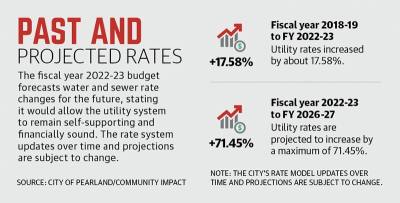The water projects, which will be completed over the next one to two years, are some of the largest construction projects in Pearland history. They include a new surface water treatment plant and expanding the John Hargrove Environmental Complex Water Reclamation Facility, or JHEC.
The fiscal year 2022-23 overall water rate increase of 13.1% is based on usage and is primarily to pay for the $175.5 million new plant, Pearland Director of Communications Joshua Lee said.
Lee said the new plant will allow the city to process around 10 million gallons of raw water per day. The new treatment plant has been in the works for nearly 20 years and is expected to be completed in mid-2023, he said.
“We won’t have to rely as heavily on the city of Houston and ground wells,” Lee said. “If we lose any one of those sources, then we have more flexibility there.”
The implementation of city wastewater projects depends on the capacity of existing facilities, Lee said. For example, once the JHEC facility reached about 70% capacity, a design phase was triggered for its expansion.
Lee said in close succession to the JHEC project being underway, the Longwood Water Reclamation Facility—which has been in place since 1965—also reached around 90% capacity, pushing the city to bring the facility up to standards.
This project entails expanding the adjacent Barry Rose Water Reclamation Facility to increase its treatment capacity from 3.1 million gallons per day to 8.5 million gallons. The Longwood facility will be decommissioned once the Barry Rose improvements are completed, according to the city’s Capital Improvement Project Division.
“Give or take, there’s about $500 million in capital projects overall that need to be done to keep water coming in and water going out,” Lee said.
Rising rates
The upcoming utility rate increase of 13.1% from the city’s approved FY 2022-23 budget is not the last of the rate hikes. The passed budget contains projections that the city will continue to increase rates overall by 16%, 19%, 15% and 8% in each of the following years, differing based on usage and meter size.
City staff said the average Pearland resident using 6,000 gallons of water monthly may not see a 13.1% rate increase, according to a budget presentation. Based on factors such as water use and meter size, the average resident may see a 9.5% increase, or about $7.53, in their monthly bills.
Lee said the city predicts possible water rate increases with its rate model. The model projects what funding it will take to maintain the city’s systems, how many customers the city will have, basic inflation and what debt financing would be required to grow the city’s systems.
“The change in water rates is designed to try to have minimal impact while accomplishing those things,” Lee said.
Some residents protested the hike in rates during the budget adoption process in September, such as resident Jimmy Davis, who said Sept. 12 that higher rates would push residents out of Pearland.
“I understand some will say, ‘Well, it’ll reduce future increases in future years.’ But that’s not going to impact next year’s economy and the hardships people are facing just putting bread on the table,” Davis said.
Pearland City Council Member Alex Kamkar, an outspoken member of the council who called for changes to the FY 2022-23 budget as it was discussed and adopted, criticized the rising price of water bills in the coming years. He said the increase in costs is influenced by fluctuating water usage in the city.
“We had the drought, and so more people bought water, and there’s other months where we have wet months where they don’t buy, and so we don’t have enough people buying water in from our system, and therefore we have to drive up the cost per gallon,” Kamkar said.
Kamkar said he believes the city should slow down its spending, saying he believes that having fewer water- and sewer-related costs for the city may reduce further rate increases. In regards to the city’s new water treatment plant, Kamkar questioned if the newfound independence from Houston water is a necessary step.
“If we had an option to buy water from the city of Houston, and they were responsible for providing it, and we could get [a price] that we could live with, and we were not raising water rates intensively, ... the question I would ask is, is this a need or a want?” Kamkar said. “If it ain’t broke, don’t fix; that would be my inclination.”
Pearland Chief Financial Officer Amy Buckert Johnson said rate increases and upgrades to water infrastructure are based on increasing demand for long-term sustainability and capacity requirements from the Texas Commission on Environmental Quality.
“A lot of times, cities have to foot the bill for what the state requires us to do,” Johnson said. “So in order to be in compliance with TCEQ, we have to make some of these system improvements and make plans for the future.”
Johnson indicated some residents may not realize the state puts mandates on cities without providing the revenue or resources to accomplish the projects.
“Citizens are footing the bill, but it’s to make sure that we’re compliant with state regulation,” Johnson said.
Other projects
Ahead of the major infrastructure projects coming next year, the city finished some other water-related projects and programs in mid- to late 2022.Pearland City Council voted in August to end the 32/30 plan, a system of processing and sending water bills to customers. The last 32/30 plan bill went out to residents in November.
The 32/20 plan was a temporary fix for a problem the city faced with the previous plan, in which meters were being read every 28 days and bills were sent once a month. That old plan caused a growing gap between when the meters were read and bills were paid, resulting in the city missing roughly $6 million in water bill payments.
The temporary 32/30 plan sought to close that gap, and in August, the plan ended and was replaced with a model that reads meters every 30 or 31 days, depending on the month. This way, a resident’s bill will be reflective of the month they receive the bill.
In the first quarter of 2023, the city will also complete the final section of its water meter replacement project. Lee said the updated water meters have been in the ground for some time, and the final step is implementing a new advanced metering infrastructure—the new industry standard for meter data collection, which is accessible through an app.
“Once that system is in place, we’ll have a customer interface where they can see hourly data usage that’s updated every single day,” Lee said.
Lee said the new data collection system will not have an impact on the cost of residents’ water bills.
Lee said he believes the process of providing high-quality water to a growing city is an underappreciated and complex task.
“Water rates, it’s a tense topic, but, you know, if you look at how our model works and the conversations we have around it, it’s extremely logical,” Lee said. “There’s a system that needs support, and this is the mechanism to do it.”







